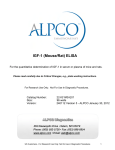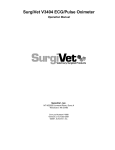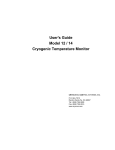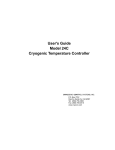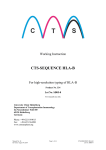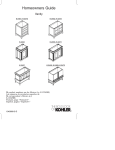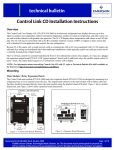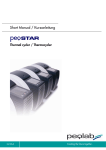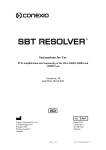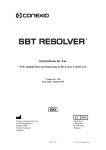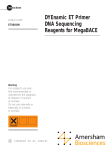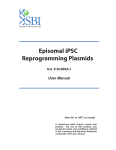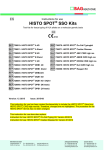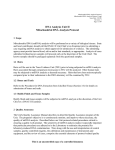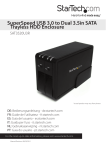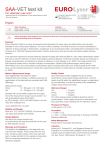Download Protrans Sequencing Testkits (SBT)
Transcript
= User Manual = = = = = = = = HLA = = = SBT = = = = = = = = = = = = = = = = = = = = = = = = = = = M Protrans medizinische diagnostische Produkte GmbH D- 68766 Hockenheim, Ketschau 2, Germany Tel.: + 49-(0)6205-29299-0 Fax: + 49-(0)6205-29299-20 www.protrans.info - [email protected] = Contents Page Protrans HLA SBT Testkits 1 1.0 Protrans Sequencing Strategy 3 2.0 PROTRANS HLA Sequencing System 4 2.0 PROTRANS Sequencing Kits, (S4, S3, Domino Stones, S2, S1) 4 3.0 Protrans Sequencing Procedure 8 4.0 Materials supplied with the HLA Sequencing Kits 9 5.0 Storage and Shelf Life of Testreagents 17 6.0 Precautions and Warnings 17 6.1 Materials and Equipment not supplied with the Kit PRE PCR 18 6.2 Materials and Equipment not supplied with the Kit POST PCR 19 7.0 Preparation and Processing of Samples 20 7.1 DNA Extraction and DNA concentration 20 8.0 Program Thermocycler Protrans SBT 21 9.0 Specificities of the Amplification Primers 22 10.0 PROTRANS S4 Sequencing Kits 22 10.1 PROTRANS S4 Sequencing Kits pre-coated PCR Strips 23 10.2 Set up Amplification PROTRANS S4 Sequencing Kits 24 10.3 PROTRANS S3 Sequencing Kits 25 10.4 PROTRANS S3 Sequencing Kits pre-coated PCR Strips 26 10.5 Set up Amplification PROTRANS S3 Sequencing Kits 26 10.6 PROTRANS Domino Stones Sequencing Kits 27 10.7 Set up Amplification PROTRANS Domino Stones Sequencing Kits 27 10.8 PROTRANS S2 Sequencing Kits 28 10.9 PROTRANS S2 Sequencing Kits pre-coated PCR Strips 28 10.10. Set up Amplification PROTRANS S2 Sequencing Kits 28 10.11 PROTRANS S1 Sequencing Kits 29 10.12. Set up Amplification PROTRANS S1 Sequencing Kits 29 11.0 Analysis of PCR Amplification results Determing the Haplotypes 30 12.0 Documentation of positive Reactions Assignment of Haplotypes 30 13.0 PROTRANS Attachment 32 14.0 Purification of the Haplotypes (positive PCR-Products) 33 14.1 PROTRANS AmpliPur-Fast 33 ® 14.2 ExoSAP-IT Purification 33 14.3 Beads fishing method 34 15.0 Selection of Sequencing Primers 34 15.1 Set up Sequencing Reaction 2 Haplotypes 35 15.2 Set up Sequencing Reaction only 1 Haplotype or a locus specific amplification (LSA) 35 16.0 Set up Sequencing Reaction 36 17.0 Purifying sequencing Reactions 37 17.1 PROTRANS DyePUR 37 17.2 Ethanol Precipitation 38 17.3 Alternative purification methods 39 18.0 Preparing Sequencing Reactions for capillary electrophoresis 39 19.0 Running the Instruments 40 20.0 Identifying HLA alleles PROTRANS Allele Identification Software 40 21.0 Sample naming conventions 41 22.0 Performing Allele Identification 42 23.0 Trouble shooting Guide 42 = Protrans = User Manual SBT Version 2010 07 01 1 Protrans Sequencing Testkits (SBT) = Protrans S4 REF 34 01 34 02 34 03 34 04 24 1415 Single Allele and Locus Specific Sequencing System Article Protrans S4 HLA-A Protrans S4 HLA-B Protrans S4 HLA-C Protrans S4 HLA-DRB1 Protrans HLA-B*5701 = Protrans S3 REF 33 01 33 02 33 03 33 04 33 09 Allele and Locus Specific Sequencing System Article Protrans S3 HLA-A Protrans S3 HLA-B Protrans S3 HLA-C Protrans S3 HLA-DRB1 Protrans S3 HLA-DQB1 Protrans Haplotype-Specific Sequencing System = Domino Stones REF= 541 01_13 542 01_15 543 01_13 544 01_14 539 01_09 641 01_13 542 01_15 543 01_13 644 01_14 639 01_09 Article= Protrans Domino Stones HLA-A Protrans Domino Stones HLA-B Protrans Domino Stones HLA-C Protrans Domino Stones HLA-DRB1 Protrans Domino Stones HLA-DQB1 REF 32 04 32 08 C0197= C0197= C C0197 C0197 c C0197= C0197= C C0197 C c C0197= C0197= C C0197 C = Protrans S2 c Allele-Group-Specific Sequencing Article Protrans S2 HLA-DRB1 Protrans S2 HLA-DQA1 c C0197 C = = Protrans S1 REF= 31 01 21 01 31 02 21 02 31 03 31 05 31 06 31 07 31 09 31 10 31 11 Locus-Specific Sequencing System Article= Protrans S1 HLA-A Protrans S1 HLA-A swift Protrans S1 HLA-B Protrans S1 HLA-B swift Protrans S1 HLA-C Protrans S1 HLA-DRB3 Protrans S1 HLA-DRB4 Protrans S1 HLA-DRB5 Protrans S1 HLA-DQB1 Exon 2 Protrans S1 HLA-DQB1 Exon 3 Protrans S1 HLA-DPB1 c C0197= C0197= C0197= C0197= C= C0197= C0197= C0197= C= C C= = Protrans S4 Protrans S3 Protrans S2 Protrans S1 24 24 24 24 24 240 Protrans Domino Stones IVDD For In-Vitro-Diagnostic use = I Amplification Unit 1 pre-pipetted PCR-Strips Amplification Unit 2 Sequencing Unit = 2 = Protrans User Manual SBT Version 2010 07 01 4°-8°C -20°C -20°C 1.0 PROTRANS Sequencing Strategy The Protrans Kits should be used in accordance with the current guidelines for quality assurance established by the European Federation for Immunogenetics (EFI) or the American Society for Histocompatibility and Immunogenetics (Ashi). Sequencing gives the most reliable and accurate information of the DNA sequence of a gene and is therefore of particular interest to fully characterize the genetic complexity and allelic diversity of the HLA genes in the human major histocompatibility complex (MHC). The full complexity of allelic diversity in HLA class I and class II makes PCR-SBT the method of choice for HLA typing. HLA typing by means of sequencing should be considered whenever the HLA type of an individual is needed. The recent developments have made sequencing equally simple and robust making it attractive for patient-related diagnostic and bone marrow registry typing. With the Protrans Sequencing System it is easy to type in low or high throughput formats at each level of automation and resolution desired. Sequencing can be carried out manually or fully automated depending on the laboratory’s individual requirements. Sequencing a gene will give the most reliable and accurate information of the DNA. The quantity of known and permanently new identified HLA genes in the human major histocompatibility complex (MHC) requires a high resolution, unambiguous and precise typing method for HLA-Alleles Class I and Class II. The Protrans Sequencing System is a practical, reliable and adjustable typing method. With the Protrans Sequencing System it is easy to type all HLA loci in the daily routine low or high throughput formats manually or at each level of automation and resolution desired. Protrans Sequencing System is easy to use not only for application in the bone marrow registry, but also as diagnostic tool for patient characterization in daily routine. © With the Software SEQUENCE PILOT it is easy to do the analysis of the Sequencing Files of the Protrans Sequencing System for HLA Class I und Class II. Protrans Sequencing-Strategies = 1 PROTRANS S4 Splitting the Haplotypes single-allele and Locus specific amplification and sequencing No Ambiguities 2 PROTRANS S3 Splitting the Haplotypes single-allele and locus specific amplification and sequencing No Ambiguities 3 PROTRANS Domino Stones Haplotype specific sequencing. No Ambiguities Domino Stones get your LCT, SSP, SSO results high 4 PROTRANS S2 Splitting the Haplotypes HLA group specific amplification and sequencing 5 PROTRANS S1 HLA-locus specific amplification and sequencing (LSA) Protrans = User Manual SBT Version 2010 07 01 3 2.0 PROTRANS HLA Sequencing System The Protrans Sequencing System is designed to reach a maximum level of allele-specific sequencing and in turn the lowest number of ambiguities. With the separation of the DNA with specific primer Mixes in two separate Haplotypes ensures the recognition of both alleles in nearly all cases. The Protrans Sequencing System allows in HLA class I sequencing of Exon 1 to Exon 4. in HLA class II sequencing of Exon 2 and codon 86TG Special emphasis was put on the complete coverage of exons 1, 2, 3, and 4 to sort out nearly all ambiguities caused by variations outside Exons 2 and 3 as well as on the location of the sequencing primers to ensure complete Exon sequences in both orientations. Intended use Protrans Sequencing System is easy to use for the application of bone marrow registry typing as well as a diagnostic tool for patient characterization in daily routine. Protrans S4 Sequencing Kits The Protrans S4 HLA SBT Typing kits are designed to reach a maximal level of allele-specific sequencing and in turn the lowest number of ambiguities. This is achieved by splitting the Haplotypes before sequencing each Haplotype separately. In HLA class I the DNA will be amplified with up to 14 Group-Specific PCR Amplifications (GSA) and in addition a locus specific Amplification (LSA) in parallel covering Exons 1, Exon 2, Exon 3 and Exon 4. The Single Allele or Group-Specific Primer Mixes are pre-pipetted in 16-well PCR-Strips In almost all cases sequence analysis of separately both alleles will be achieved. In HLA class I special emphasis was put on the complete coverage of Exons 1, 2, 3, and 4 to sort out nearly all ambiguities caused by variations outside Exons 2 and 3. In HLA class II the DNA will be amplified with up to 14 Group-Specific PCR Amplifications (GSA) in parallel covering the complete Exon 2 loci. The Single Allele or Group-Specific Primer Mixes are pre-pipetted in 16-well PCR-Strips In almost all cases sequence analysis of both alleles separately will be achieved. In HLA-DRB1 a special emphasis was put on the separation of the DR52-associated HLA-DRB1 alleles to ensure unambiguous results in nearly all samples Special emphasis was put on the location of the sequencing primers to ensure complete Exon sequences in both orientations. For ease of use • • • • • 4 = The Group-Specific Primer Mixes are pre-pipetted in 8-well PCR-Strips The Test procedure and the Thermocycler program for the Amplification, Cycle Sequencing and the Settings of the Sequencer are for all Protrans Sequencing Kits and for all HLA loci identical The Purification of the PCR Products and Sequencing Products are identically for all HLA loci. It is very easy to type different HLA loci of several DNA Samples in parallel. It is always possible to combine the different Protrans Sequencing Kits in the different Protrans Sequencing Strategies. Protrans User Manual SBT Version 2010 07 01 Protrans S3 Sequencing Kits The Protrans S3 Sequencing Kits are designed to match the requirements of high sample throughput as well as allele-specific sequencing for less ambiguities. This is achieved by splitting the Haplotypes before sequencing each Haplotype separately. In the Protrans SBT Test kit HLA-A, B, C the DNA will be amplified with 7 Group-Specific PCR Amplification Mixes (GSA) and in addition a Locus specific Amplification Mix (LSA). In the Protrans SBT Test kit HLA-DQB1 the DNA will be amplified with 6 Group-Specific PCR Amplifications Mixes (GSA) and in addition 2 Locus specific Amplification Mixes (LSA). In the Protrans SBT Test kit HLA-DRB1 the DNA will be amplified with 8 Group-Specific PCR Amplifications (GSA). = If the GSA reactions do not indicate two separate alleles the LSA reaction must be sequenced. This ensures in all cases the recognition of both alleles.== In the Protrans SBT Test kit HLA-class I Exons 1, Exon 2, Exon 3 and Exon 4 and in the Protrans SBT Test kit HLA-class II Exon 2 (DRB1, DQB1) and Exon 3 (DQB1)are covered. The Amplification Primer Mixes are pre-pipetted in 8-well PCR-Strips and each HLA-locus in a different colour. In most cases sequence analysis of separately both alleles will be achieved. In HLA class I special emphasis was put on the complete coverage of Exons 1, 2, 3, and 4 to sort out nearly all ambiguities caused by variations outside Exons 2 and 3. Special emphasis was put on the location of the sequencing primers to ensure complete Exon sequences in both orientations. For ease of use • • • • • The Group-Specific Primer Mixes are pre-pipetted in 8-well PCR-Strips The Test procedure and the Thermocycler program for the Amplification, Cycle Sequencing and the Settings of the Sequencer are for all Protrans Sequencing Kits and for all HLA loci identical. The Purification of the PCR Products and Sequencing Products are identically for all HLA loci. It is very easy to type different HLA loci of several DNA Samples in parallel. It is always possible to combine the different Protrans Sequencing Kits in the different Protrans Sequencing Strategies. Protrans Domino Stones HLA SBT are designed for a maximal flexibility to match individual requirements of the HLA laboratory. The Domino Stones Locus- and different Group-Specific PCR Amplification Mixes (Domino Stones) are supplied separately to allow an individual set up according to the individual requirements. Using the Protrans Domino Stones it is for all HLA loci possible to change the low resolution typing result from other techniques (SSP or SSO) in a 4 digit high resolution result. The Locus- and Group-Specific PCR Amplifications are covering at least Exons 2 and 3 in HLA class I loci and Exon 2 in HLA class II loci. Protrans = User Manual SBT Version 2010 07 01 5 Protrans S2 Sequencing Kits The Protrans S2 sequencing kits are designed to match the requirements of very high sample throughput as well as allele-specific sequencing for less ambiguities. This is achieved by applying 4 Group-Specific PCR Amplifications (GSA) in parallel covering at least exons 2 and 3 in HLA class I loci and exon 2 in HLA class II loci allowing in many cases sequence analysis of both alleles separately. For ease of use • • • • • The Group-Specific Primer Mixes are pre-pipetted in 8-well PCR-Strips The Test procedure and the Thermocycler program for the Amplification, Cycle Sequencing and the Settings of the Sequencer are for all Protrans Sequencing Kits and for all HLA loci identical. The Purification of the PCR Products and Sequencing Products are identically for all HLA loci. It is very easy to type different HLA loci of several DNA Samples in parallel. It is always possible to combine the different Protrans Sequencing Kits in the different Protrans Sequencing Strategies. Protrans S1 Sequencing Kits The Protrans S1 sequencing kits are designed to match the requirements of very high sample throughput. This is achieved by Locus-Specific PCR Amplification (LSA) covering in HLA class I Exon 1, Exon 2, Exon 3 and Exon 4, and in HLA class II Exon 2, allowing sequence analysis of both alleles simultaneously. A special emphasis was put on the location of the sequencing primers to ensure complete Exon sequences in both orientations. Protrans Sequencing Kits Protrans S1 swift REF 2101 and 2102 are a variant of Protrans S1 Kits. These Kits are designed to match the requirements of very high sample throughput. This is achieved by Locus-Specific PCR Amplification (LSA) covering Exons 2 and 3 in HLA class I loci leaving ambiguities due to variations outside Exon 2 and 3 unsolved. A special emphasis was put on the generation of short PCR Products to increase robustness in case of DNA of lower quality. For ease of use • • • • • 6 = The Group-Specific Primer Mix is in a single Tube. The Test procedure and the Thermocycler program for the Amplification, Cycle Sequencing and the Settings of the Sequencer are for all Protrans Sequencing Kits and for all HLA loci identical. The Purification of the PCR Products and Sequencing Products are identically for all HLA loci. It is very easy to type different HLA loci of several DNA Samples in parallel. It is always possible to combine the different Protrans Sequencing Kits in the different Protrans Sequencing Strategies. Protrans User Manual SBT Version 2010 07 01 Primer Mix Specificities and Specification Tables The Protrans HLA Sequencing Kits are continuously updated. In order to provide the user with the most recent version of the kit, the Primer Mix Specifications are listed as an Attachment in the Primer Mix Specification Tables. Please make sure that the version of the kit is identical with the version of the Primer Mix Specification Table. PCR Amplification The method is based on PCR amplifications starting with genomic DNA. The PCR amplification reactions are covering at least Exons 2 and 3 in HLA class I loci and Exon 2 in HLA class II loci and have been designed to be specific for a single group of alleles only. Each of the PCR formulations has been validated against a panel of well characterized cell lines to ensure against non-specific amplification and preferential amplification of one allele over another in heterozygous combinations. Sequencing After PCR clean up the positive Group-Specific Amplification reactions are used as templates for direct sequencing at least Exons 2 and 3 in HLA class I loci and Exon 2 in HLA class II loci. The PCR templates have been optimized for the use of dye terminator cycle sequencing chemistries to generate the allele typing information. Allele Assignment The final step in sequence analysis consists out of the allele assignment using the © SEQUENCE PILOT allele identification Software. This program performs allele identification, allows manual reviewing or editing of the sequencing data as well as reporting, exporting and © archiving of sequences or results SEQUENCE PILOT allele identification software enables quick and easy allele assignment. The software allows manual reviewing or editing of the sequencing data of Exon 1 to Exon 8. Heterozygous positions as well as mismatches are detected and reported. Typing results and sequence electropherograms can be printed, exported and archived. The software is available as a Windows™ single-user-version or as a Windows™ or Linux™ server-client-version for use in a network with several workstations. The HLA database is continuously updated in line with the latest scientific research of the official IMGT/HLA database. Instrument Platforms The PCR and sequencing cycle profiles provided in this manual have been used with the Thermal Cyclers from Applied Biosystems GeneAmp PCR Systems 2700, 9600 and 9700. They should also work with compatible instruments but may require adjustments of the cycling profile or emulation of the above instruments. © The Sequencing Kits as well as the SEQUENCE PILOT Allele Identification Software are compatible with all four-dye capillary-sequencing instruments available. Applied Biosystems Capillary: 310, 3100, 3130A, 3130xl ,3500, 3500xl, 3730, 3730xl GE Healthcare Capillary: MegaBACE 500, 1000, 4000 Beckman Capillary: CEQ8000; GeXP Protrans = User Manual SBT Version 2010 07 01 7 3.0 Procedure Protrans Sequencing System Pre-PCR Separation of Haplotypes DNA Amplification PCR SSP = = = Post PCR Purification of the separated Haplotypes HLA Class I Sequencing the single Haplotypes EXON 1-2-3-4 forward and reverse HLA Class II EXON 2 forward and reverse and codon 86TG 8 = Purification of the Sequencing Products Running Sequencing Products on all Sequencers Automated Analysis of the Sequencing results Protrans Software Sequence Pilot© Protrans User Manual SBT Version 2010 07 01 4.0 Materials supplied with the HLA Sequencing Kits = Amplification Unit 1 Pre-PCR Protrans S4 HLA-A Single Allele and Locus-specific Sequencing 16 well PCR Strips (yellow) precoated with Primer Mixes Primer Mixes 12 x GSA 1x LSA 1x neg.ctrl. Typings I 24 4-8°C Protrans S3 HLA-A I Single Allele and Locus-specific Sequencing 8 well PCR Strips (yellow) precoated with Primer Mixes = Protrans S4 HLA-B Single Allele and Locus-specific Sequencing 16 well PCR Strips (blue) precoated with Primer Mixes 7 x GSA 1 x LSA Primer Mixes 12 x GSA 1x LSA 1x neg.ctrl. 24 4-8°C Typings I 24 4-8°C Protrans S3 HLA-B I Single Allele and Locus-specific Sequencing 8 well PCR Strips (blue) precoated with Primer Mixes = Protrans S4 HLA-C Single Allele and Locus-specific Sequencing 16 well PCR Strips (green) precoated with Primer Mixes 7 x GSA 1 x LSA Primer Mixes 12 x GSA 1x LSA 1x neg.ctrl. 24 4-8°C Typings I 24 4-8°C Protrans S3 HLA-C I Single Allele and Locus-specific Sequencing 8 well PCR Strips (green) precoated with Primer Mixes = Protrans S4 HLA-DRB1 Single Allele and Allele-Group specific Sequencing 16 well PCR Strips (natural) precoated with Primer Mixes 7 x GSA 1 x LSA Primer Mixes 14 x GSA 1x pos.ctrl. 1x neg.ctrl. 24 4-8°C Typings I 24 4-8°C Protrans S3 HLA-DRB1 Single Allele and Allele-Group specific Sequencing 8 well PCR Strips (natural) precoated with Primer Mixes Protrans S2 HLA-DRB1 Allele Group specific Sequencing 4 well PCR Strips (natural) precoated with Primer Mixes = Protrans S2 HLA-DQA1 Allele Group specific Sequencing 4 well PCR Strips precoated with Primer Mixes = I 8 x GSA 24 4-8°C Primer Mixes Typings I 4 x GSA 24 4-8°C Primer Mixes Typings I 4 x GSA 24 4-8°C Protrans S3 HLA-DQB1 Single Allele and Locus-Specific Sequencing 8 well PCR Strips (pink) precoated with Primer Mixes = = Protrans = User Manual SBT I 6 x GSA 2 x LSA 24 Version 2010 07 01 4-8°C 9 = = Amplification Unit 2 = Protrans S4 HLA-A Single Allele and Locus-specific Sequencing PCR Solution D = Solution Tubes Volume/µl I PSD 4x 1.750 -20°C Protrans S3 HLA-A Single Allele and Locus-specific Sequencing PCR Solution D Negative control = I PSD NC-ABC 2x 1x 1.750 140 Protrans Domino Stone HLA-A Haplotype-specific Sequencing Allele- and Allele-Group specific Amplification PCR Solution L = I GSA PSL 1x 3x 1.400 1.000 Protrans S1 HLA-A Locus-specific Sequencing (LSA) EXON 1-4 Locus-specific Amplification Primer = Protrans S1 HLA-A swift Locus-specific Sequencing (LSA) EXON 2-3 Locus-specific Amplification Primer = = Protrans -20°C -20°C I LSA 1x 360 -20°C LSA 1x 360 -20°C = = 10 -20°C -20°C User Manual SBT Version 2010 07 01 = Amplification Unit 2 = Protrans S4 HLA-B Single Allele and Locus-specific Sequencing PCR Solution D = Solution Tubes Volume/µl I PSD 4x 1.750 -20°C Protrans S3 HLA-B Single Allele and Locus-specific Sequencing PCR Solution D Negative control = I PSD NC-ABC 2x 1x 1.750 140 Protrans Domino Stone HLA-B Haplotype-specific Sequencing Allele- and Allele-Group specific Amplification PCR Solution L = I GSA PSL 1x 3x 1.400 1.000 Protrans S1 HLA-B Locus-specific Sequencing (LSA) EXON 1-4 Locus-specific Amplification Primer = Protrans S1 HLA-B swift Locus-specific Sequencing EXON 2-3 Locus-specific Amplification Primer -20°C -20°C -20°C -20°C I LSA 1x 360 -20°C LSA 1x 360 -20°C Solution Tubes Volume/µl I PSD 4x 1.750 -20°C = = = = = = Amplification Unit 2 = Protrans S4 HLA-C Single Allele and Locus-specific Sequencing PCR Solution D = Protrans S3 HLA-C Single Allele and Locus-specific Sequencing PCR Solution D Negative control = I PSD NC-ABC 2x 1x 1.750 140 Protrans Domino Stone HLA-C Haplotype-specific Sequencing Allele- and Allele-Group specific Amplification PCR Solution L = I GSA PSL 1x 3x 1.400 1.000 Protrans S1 HLA-C Locus-specific Sequencing EXON 2-4 Locus-specific Amplification Primer = = = -20°C -20°C -20°C -20°C I LSA 1x 360 -20°C = Protrans = User Manual SBT Version 2010 07 01 11 = Amplification Unit 2 = Protrans S4 DRB1 Allele- and Allele-Group specific Sequencing PCR Solution D = Solution Tubes Volume/µl I PSD 4x 1.750 -20°C Protrans S3 DRB1 Allele- and Allele-Group specific Sequencing PCR Solution D Negative control = I PSD NC-ABC 2x 1x 1.750 140 Protrans Domino Stone DRB1 Haplotype-specific Sequencing Allele- and Allele-Group specific Amplification PCR Solution L = I GSA PSL 1x 3x 1.400 1.000 Protrans S2 DRB1 Allele-and Allele-Group-specific Sequencing PCR Solution D = Protrans S1 HLA-DRB3 Locus-specific Sequencing Locus-specific Amplification = -20°C -20°C -20°C -20°C I PSD 1x 1.750 -20°C Solution Tubes Volume/µl I LSA 1x 360 -20°C Solution Quantity Volume/µl I LSA 1x 360 -20°C Solution Quantity Volume/µl I LSA 1x 360 -20°C Solution Tubes Volume/µl I PSD NC-DQ 2x 1x 1.750 140 -20°C -20°C = Protrans S1 HLA-DRB4 Locus-specific Sequencing Locus-specific Amplification = Protrans S1 HLA-DRB5 Locus-specific Sequencing Locus-specific Amplification = = Protrans S3 HLA-DQB1 Single Allele and Locus-specific Sequencing PCR Solution D Negative control = Protrans Domino Stone HLA-DQB1 Haplotype-specific Sequencing Allele- and Allele-Group specific Amplification PCR Solution L I GSA PSL 1x 3x 1.400 1.000 -20°C -20°C = = = Protrans S1 HLA-DQB1 EXON 2 Locus-specific Sequencing Locus-specific Amplification = I LSA 1x 360 Protrans S1 HLA-DQB1 EXON 3 Locus-specific Sequencing Locus-specific Amplification I LSA 1x 360 = 12 = Protrans -20°C User Manual SBT Version 2010 07 01 -20°C = Protrans S2 HLA-DQA1 Allele Group specific Sequencing PCR Solution D = = Protrans S1 HLA-DPB1 Locus-specific Sequencing Locus-specific Amplification Solution Tubes Volume/µl I PSD 1x 1.750 -20°C Solution Tubes Volume/µl I LSA 1x 360 -20°C = Content of the Amplification Unit components Protrans S4 precoated Strips 5’ and 3’-primers Cresol red in the negative control well (last position) Protrans S3 precoated Strips 5’ and 3’-primers Protrans S2 precoated Strips 5’ and 3’-primers Protrans Domino Stone Primer Mix 5’ and 3’-primers Protrans S1 LSA Mix PCR-Solution D (PSD) PCR-Solution L (PSL) Negative Control (NC) Protrans = 5’ and 3’-primers Buffer Nucleotides Buffer Nucleotides Buffer Nucleotides 5’ and 3’-primers User Manual SBT Version 2010 07 01 13 Sequencing Unit Post PCR Area = Protrans HLA-A Testkit Sequencing Primers Exon 1 forward (natural) Exon 1 reverse (natural) Exon 2 forward (red) Exon 2 reverse (red) Exon 3 forward (blue) Exon 3 reverse (blue) Exon 4 forward (yellow) Exon 4 reverse (yellow) Tubes µl I 1x 360 -20°C A-E1R 1x 360 -20°C x A-E2F 1x 5x 360 -20°C x x A-E2R 1x 5x 360 -20°C x x x A-E3F 1x 5x 360 -20°C x x x x A-E3R 1x 5x 360 -20°C x x x A-E4F 1x 360 -20°C x x x A-E4R 1x 360 -20°C 1 x;S4 2 x 400 4-8°C µl I S4 S3 S1 x x x S1 sw Do. St. Tube S4, S3, S2 x A-E1F x x x x x x x x x x x x Agarose-Gel Loading Buffer (colourless) LB Do. St Protrans HLA-B Testkit Sequencing Primers Exon 1 forward (natural) Exon 1 reverse (natural) Exon 2 forward (red) Exon 2 reverse (red) Exon 3 forward (blue) Exon 3 reverse (blue) Exon 4 forward (yellow) Exon 4 reverse (yellow) Tubes S4 S3 S1 x x x S1 sw Do. St. Tube S4, S3, S2 x B-E1F 1x 360 -20°C x x B-E1R 1x 360 -20°C x x x x x B-E2F 1x 5x 360 -20°C x x x x x B-E2R 1x 5x 360 -20°C x x x x x B-E3F 1x 5x 360 -20°C x x x x x B-E3R 1x 5x 360 -20°C x x x B-E4F 1x 360 -20°C x x x B-E4R 1x 360 -20°C 400 4-8°C Agarose-Gel Loading Buffer (colourless) 14 = Protrans User Manual SBT LB Do.St 1 x;S4 2 x Version 2010 07 01 Protrans HLA-C Testkit Sequencing Primers Exon 1 forward (natural) Exon 1 reverse (natural) Exon 2 forward (red) Exon 2 reverse (red) Exon 3 forward (blue) Exon 3 reverse (blue) Exon 4 forward (yellow) Exon 4 reverse (yellow) S4 S3 Tubes Do. St. S1 Tube in preparation C-E1F in preparation C-E1R S4, S3, S2 Do. St µl I x x x = x C-E2F 1x 5x 360 -20°C x x x = x C-E2R 1x 5x 360 -20°C x x x = x C-E3F 1x 5x 360 -20°C x x x = x C-E3R 1x 5x 360 -20°C x x x C-E4F 1x 360 -20°C x x x C-E4R 1x 360 -20°C LB 1 x;S4 2 x Agarose-Gel Loading Buffer (colourless) 400 4-8°C Protrans HLA-DRB1 Testkit Sequencing Primers Exon 2 forward (blue) Exon 2 reverse (red) Tubes S4 S3 S2 Do. St. x x x x x x x x x x x Exon 2 Codon 86TG = x Agarose-Gel Loading Buffer (colourless) = Tube S4, S3, S2 Do. St µl I 1x 5x 360 -20°C 1x 5x 360 -20°C 1x 1x 360 -20°C 400 4-8°C DRE2F DRE2R DRcodon 86TG LB 1 x;S4 2 x Protrans HLA-DRB 3; 4; 5 Testkit Tubes Sequencing Primers Exon 2 forward (blue) Exon 2 reverse (red) S1 x x Agarose-Gel Loading Buffer (colourless) = Protrans = User Manual SBT Tube DRE2A DRE2B LB S1 µl I 1x 360 -20°C 1x 360 -20°C 1x 400 4-8°C Version 2010 07 01 15 Protrans HLA-DQB1 Exon 2 Testkit Tubes Sequencing Primers Exon 2 forward (blue) Exon 2 reverse (red) S1 Do. St. x x x x Agarose-Gel Loading Buffer (colourless) Tube DQB2F DQB2R S1 Do. St µl I 1x 5x 360 -20°C 1x 5x 360 -20°C 400 4-8°C LB 1x Protrans HLA-DQB1 Exon 3 Testkit Tubes Sequencing Primers Exon 3 forward (blue) Exon 3 reverse (red) S1 Do. St. x x x x Agarose-Gel Loading Buffer (colourless) Tube DQB3F DQB3R S1 Do. St µl I 1x 5x 360 -20°C 1x 5x 360 -20°C 400 4-8°C LB 1x Protrans HLA-DQB1 Exon 2 + 3 Testkit Sequencing Primers Exon 3 forward (blue) Exon 3 reverse (red) Tubes S3 Do. St. Tube S3 Do. St µl I x x DQB-F 2x 5x 360 -20°C x x DQB-R 2x 5x 360 -20°C 400 4-8°C Agarose-Gel Loading Buffer (colourless) LB 1x Protrans HLA-DQA1 Testkit Sequencing Primers Exon 2 forward (blue) Exon 2 reverse (red) Tubes S2 DQAE2F DQAE2R x x Agarose-Gel Loading Buffer (colourless) 16 = Protrans Tube User Manual SBT LB S2 µl I 1x 360 -20°C 1x 360 -20°C 400 4-8°C 1x Version 2010 07 01 Protrans HLA-DPB1 Testkit Tubes Sequencing Primers Exon 2 forward (blue) Exon 2 reverse (red) S1 x x Agarose-Gel Loading Buffer (colourless) Tube DPBE2F DPBE2R LB S1 µl I 1x 360 -20°C 1x 360 -20°C 400 4-8°C 1x = Content of the Sequencing Unit components Sequencing Primers 5’ and 3’-primers Loading Buffer Gel Loading Solution Note Refer to the Primer Mix Specificity Tables (Attachment) delivered with the kits to select the appropriate PCR products and Sequencing Primers. Make sure that the version of the kit and the version of the Primer Mix Specificity Tables are identical Note All reagents supplied with the Protrans HLA Sequencing Kits should be used Amplification Primer Version specific and Sequencing Primer LOT specific Amplification Primer can not be mixed between different Versions as indicated on the Attachment of each Kit Sequencing Primer can not be mixed between different LOT´s as indicated as indicated on the Attachment of each Kit Note In case of damaged tubes or boxes malfunctions cannot be excluded. Those Kits must not be used. Protrans = User Manual SBT Version 2010 07 01 17 5.0 Storage and Shelf Life = I Pre PCR Area Amplification Unit 1 Precoated Strips Amplification Unit 2 Buffers 4 – 8 °C -20°C = I Post PCR Area Sequencing Unit -20°C Sequencing Primers = When stored under appropriate conditions the kit components can be used until the expiry date indicated on the Pre PCR Box and Post PCR Box kit. Open packages and Tubes must be closed and stored under the same conditions as closed packages and Tubes and can be used until their expiry date. Only components of the same kit Version can be used with each other and only until the marked expiry date 6.0 Precautions and Warning: IIVDI Reagents only for In Vitro Diagnostic use In the US only for research (RUO) The PROTRANS Testkits must be performed by well-trained and authorised laboratory technicians. All reagents should be handled in accordance to good laboratory practice using appropriate precautions. In addition , handle all patient samples as potentially infectious. Do not pipette by mouth. All used PCR-Cyclerplates should be treated as potentially infectious and should be destroyed according to the valid national guidelines. Do not use reagents which are expired. See expiration date printed on the label. Pre-PCR and Post-PCR rooms must be strictly separated. Use separate pipettes in the Pre-PCR area and in the Post-PCR area Ethidium bromide used for staining of DNA is a potential carcinogen. Always wear protective gloves when handling stained gels. Waste management according to national guidelines. Wear UV-blocking eye protection and avoid direct UV light when viewing or photographing gels. See Material Safety Data Sheet (MSDS) for detailed information. Available from Protrans. 18 = Protrans User Manual SBT Version 2010 07 01 6.1 Materials and Equipment not supplied with the Kit Pre PCR Area 1 © SEQUENCE PILOT Software for automated allele assignment PROTRANS PROTRANS Pipetting Assistant (PPA) Software for documentation of DNAsamples (pipetting regime). Transfer of generated information to the Platerecord of the sequencer PROTRANS DNA Extraction PROTRANS DNA Box 500 PROTRANS Photometer for adjusting DNA concentration multiple suppliers Protrans PCR Workstation deep frozen block for pipetting PCR PROTRANS Vortexer multiple suppliers Mini Centrifuge TM AmpliTaq Gold multiple suppliers polymerase (5U/µl) Applied Biosystems = Eppendorf Tubes 1,5ml Rainin EDP3-plus electronic Multistepper Rainin L-20 Pipet-Lite 20-200µl Dispensing Mastermix PROTRANS 2-20µl Taq-polymerase PROTRANS Rainin L-1000 Pipet-Lite 100-1000µl PSD PROTRANS 2-20µl GP-L10F red PROTRANS 20-200µl GP-L 200F green PROTRANS 100-1000µl GP-L 1000F blue PROTRANS Pipettes filter tips Closing roller PCR-caps multiple suppliers Thermal cycler with heated lid Note The PCR and sequencing cycle profiles provided in this manual have been used with the Thermal Cyclers from Applied Biosystems GeneAmp PCR Systems 2700, 9600 and 9700. They should also work with compatible instruments but may require adjustments of the cycling profile or emulation of the above instruments. See Appendix A, troubleshooting guide. Protrans = User Manual SBT multiple suppliers Version 2010 07 01 19 6.2 Materials and Equipment not supplied with the Kit = Post PCR Area ® Rainin L-20 Pipet-Lite Rainin EDP3 E3-20 Electronic Multistepper Rainin EDP3 E3-100 Electronic Multistepper Rainin EDP3-Plus E8-20 Electronic Multistepper 8 channel Multistepper Rainin EDP3-Plus E8-300 Electronic Multistepper 8 channel Multistepper Pipettes filter tips 2-20µl ExoSAP–IT ; Set-up sequencing reaction PROTRANS 2-20µl Big-Dyes PROTRANS 10-100µl Sequencing primers PROTRANS 2-20µl PCR products PROTRANS 20-300µl Ethanol precipitation PROTRANS 2-20µl GP-L10F red PROTRANS 20-200µl GP-L 200F green PROTRANS 200-300µl RT-L300F blue Elektrophorese Unit PROTRANS Gel Check or Protrans Quattro-Gel Check 4 x 96 Amplificats in 4 Gels in 1 chamber Agarose, molecular biology grade PROTRANS 1x TAE/TBE-Buffer PROTRANS Heating block multiple suppliers Microwave oven Ethidium bromide solution (10mg/ml) multiple suppliers W PROTRANS PROTRANS WARNING CHEMICAL HAZARD. Ethidium bromide is a known mutagen. It can change genetic material in a living cell. Before using ethidium bromide, read the manufacturer’s MSDS, which gives information on physical characteristics, hazards, precautions, first-aid, spill clean up, and disposal procedures. Always wear appropriate protective eyewear, clothing, and gloves. Photograph unit multiple suppliers Power supply multiple suppliers Transilluminator PROTRANS PCR 8-strips for Loading Buffer multiple suppliers PCR reaction plate 96 well and cap-strips 8 channel pipette transferring the Loading Buffer into a MicroAmp 96 –well reaction plate or MicroAmp strips for mixing the PCR Amplificats with Loading Buffer for loading into the Gel PROTRANS AmpliPUR Fast for purification of PCR products multiple suppliers ® ¹ ExoSAP-IT Exonuclease I/Shrimp Alkaline Phosphatase for purification of PCR products MicroAmp optical 96-well reaction Plate Part Number N801-0560 multiple suppliers multiple suppliers PROTRANS USB Europe GmbH www.usbweb.de Art-Nr.: 78201, 78202 ABI 1 Applied Biosystems Beckman Coulter 3 GE Healthcare 2 Automated DNA sequencing instrument and consumables ABI Sequencer ¹ Big DyeTM Terminator Cycle Sequencing Kit version 1.1 (BDT v 1.1) ² CEQ 8000 QuickStart Kit Beckmann Coulter ¹ MegaBACE DYEnamic 20 = Protrans TM TM ET Dye Terminator Kit (MegaBACE ) User Manual SBT Applied Biosystems Beckman Coulter GE Healthcare Version 2010 07 01 ¹ Applied Biosystems Note The Protrans HLA Sequencing Kits have been validated for the Applied 2 Beckman Coulter Biosystems DNA Sequencers 3100 Genetic Analyzer and 3730 DNA Analyzer. TM ¹ MegaBACE They should also work with all other four-dye sequencing instruments available GE Healthcare PROTRANS DyePUR for purification of sequencing products PROTRANS 1 GE Healthcare Sephadex G-50 Fine DNA Grade for purification of sequencing products 96er plate centrifuge for purification of sequencing products on 96-well plates. (Ethanol or PROTRANS PlatePUR) EDTA-di Sodium 0,5M multiple suppliers Na Acetate 3M solution Merck and other Ethanol absolute pro analysis 100% for ethanol precipitation method Merck HPLC water Merck Aluminium cover foil for ethanol purification PROTRANS 1 Merck and other 1 Note The reagents and instruments listed with have been validated for Protrans HLA Sequencing Kits. Protrans does not take any responsibility when other materials or equipment 1 are used. The user must validate reagent and instruments other than those listed with 2 2 Note The reagents and instruments listed with have not been validated for Protrans HLA Sequencing Kits. Protrans does not take any responsibility when these materials or equipment 2 are used. The Reagents and instruments listed with must be validated by the user. 7.0 Preparation and Processing of Samples 7.1 DNA Extraction and DNA concentration Genomic DNA can be obtained from all nucleated cells. The simplest method is to isolate DNA from cell suspensions (blood, buffy coat or cultured cells) for this multiple protocols and kits are available. For DNA sequencing only those methods should be considered which provide DNA of high quality and quantity. PROTRANS DNA Box 500 The PROTRANS DNA extraction-kit PROTRANS DNA Box 500 provides high quality DNA, optimized for PROTRANS HLA sequencing kits. Other extraction methods must be validated before used in routine sequencing. Note Use either EDTA or ACD- blood. Heparin anticoagulated blood should be avoided as heparin has been shown to seriously affect PCR yield. The DNA concentration must be 50 – 100 ng/µl = = Working with human blood samples has the potential to transmit infectious diseases and should be handled with precaution. Always wear appropriate protective eyewear, clothing, and gloves Protrans = User Manual SBT Version 2010 07 01 21 8.0 Program Thermocycler Protrans SBT All Protrans HLA Sequencing Kits (Protrans S4, S3, S2, S1, and Domino Stones) are running with the same Cycling Profiles for PCR Amplification and Cycle Sequencing The program is standardised for all HLA Loci (Important Note: Ramp Rate 1°c/s) 8.1 PCR Amplification = CR - Step Initial Denaturation Denaturation Annealing Extension Denaturation Annealing Extension Denaturation Annealing Extension Terminal cooling Volume = Temperature 95°C 96°C 64°C 72°C 96°C 60°C 72°C 96°C 56°C 72°C 4°C Time 2 min 40 sec 1 min 2 min 20 sec 1 min 2 min 20 sec 1 min 2 min Cycles Hold 15 Cycles 15 Cycles 10 Cycles ∞ Hold 15 µl Purification of PCR Products with ExoSAP-IT® 8.2 Step 1 Temperature 2 80°C 3 4°C 37°C Time Process Degradation of primers 15 min and dNTPs 15 min Degradation of enzymes After incubation and cooling to room temperature the PCR products are ready for sequencing set-up = 8.3.1 Cycle Sequencing ABI = Step Initial Denaturation Denaturation Annealing Extension Terminal-Cooling Volume = 8.3.2 Temperature 96°C 96°C 50°C 60°C 4°C Time 1 min 10 sec 5 sec 4 min Cycles Hold 25 Cycles ∞ Hold 10 µl Cycle Sequencing Beckman = Step Temperature Time Cycles Denaturation 96°C 20 sec 30 Cycles Annealing 50°C 20 sec Extension 60°C 3 min Terminal-Cooling 4°C Hold ∞ Volume 10 µl = Note The PCR and sequencing cycle profiles provided in this manual have been used with the Thermal Cyclers from Applied Biosystems GeneAmp PCR Systems 2700, 9600 and 9700. They should also work with compatible instruments but may require adjustments of the cycling profile or emulation of the above instruments. See Appendix A, troubleshooting guide. 22 Protrans User Manual SBT Version 2010 07 01 = 9.0 Specificities of the Amplification Primers The method is based on PCR amplifications starting with genomic DNA. The PCR amplification reactions are covering at least exons 2 and 3 in HLA class I loci and exon 2 in HLA class II loci and have been designed to be specific for a single group of HLA alleles only and a single HLA locus. Each of the PCR formulations has been validated against a panel of well characterized cell lines to ensure against non-specific amplification and preferential amplification of one allele over another in heterozygote combinations. The Protrans SBT Kits are continuously updated The Attachment for each kit is LOT- Version and Database-specific. For interpretation of the amplification-results and selection of the sequencing primers the Attachment delivered with the kit Version and Database-specific must be used exclusively. The Protrans HLA Sequencing Kits are continuously updated. In order to provide the user with the most recent version of the kit, the Primer Mix Specifications are listed as an Attachment in the Primer Mix Specification Tables delivered with each kit. Please make sure that the Version of the kit is identical with the Version of the ATTACHMENT the Primer Mix Specification Table in the Testkit. 10.0 PROTRANS S4 Sequencing Kits The Protrans S4 HLA SBT Typing kits are designed to reach a maximal level of allele-specific sequencing and in turn the lowest number of ambiguities. This is achieved by splitting the Haplotypes before sequencing each Haplotype separately. In HLA class I the DNA will be amplified with up to 14 Group-Specific PCR Amplifications (GSA) and in addition a locus specific Amplification (LSA) in parallel covering Exons 1, Exon 2, Exon 3 and Exon 4. The Single Allele or Group-Specific Primer Mixes are pre-pipetted in 16-well PCR-Strips In almost all cases sequence analysis of separately both alleles will be achieved. In HLA class I special emphasis was put on the complete coverage of Exons 1, 2, 3, and 4 to sort out nearly all ambiguities caused by variations outside Exons 2 and 3. In HLA class II the DNA will be amplified with up to 14 Group-Specific PCR Amplifications (GSA) in parallel covering the complete Exon 2. loci The Single Allele or Group-Specific Primer Mixes are pre-pipetted in 16-well PCR-Strips In almost all cases sequence analysis of separately both alleles will be achieved. In HLA-DRB1 a special emphasis was put on the separation of the DR52-associated HLA-DRB1 alleles to ensure unambiguous results in nearly all samples Special emphasis was put on the location of the sequencing primers to ensure complete Exon sequences in both orientations. For ease of use The Allele- and Allele-Group-Specific Primer Mixes are pre-pipetted in 16-well PCR-Strips. The colour of the strips are for each HLA-locus different. The Test procedure and the Thermocycler-program for the Amplification, for Cycle Sequencing and the Settings of the Sequencer are for all Protrans Sequencing Kits and for all HLA loci and identical. The Purification of the PCR Products and Sequencing Products are identically for all HLA loci. It is very easy to type different HLA loci of several DNA Samples in parallel. It is always possible to combine the different Protrans Sequencing Kits with the different Protrans Sequencing Strategies. Protrans = User Manual SBT Version 2010 07 01 23 10.1. Protrans S4 Sequencing Kits pre-coated PCR Strips HLA-A HLA-B HLA-C HLA-DRB1 24 = Protrans User Manual SBT Version 2010 07 01 10.2. Set-up Amplification Protrans S4 Sequencing Kits Documentation of DNA-samples with Protrans Pipetting Assistant or pipetting scheme form Place reagents and strips in PROTRANS PCR Workstation –20°C = 1 16-well PCR Strip 2 PROTRANS PCR Solution D (PSD) 3 AmpliTaq Gold DNA Polymerase 4 DNA sample Vortex all reagents and spin down with mini-table centrifuge= = Master Mix for each DNA sample Reaction tube 1,5ml 280 µl PCR Solution (PSD) 1 3,0 µl 2 AmpliTaq Gold DNA polymerase Vortex master mix and spin down with mini-table centrifuge = Master Mix in Position 14 Negative Control (N) in Protrans 16-well PCR Strip 20µl DNA sample (50-100ng/µl) in the Master Mix 4 Vortex master mix and spin down with mini-table centrifuge 3 15µl 5 15µ = Master Mix in Protrans 16-well PCR Strip with electronic Multistepper (RAININ) = Close 16-PCR strip. Place the strips in the thermocycler and start the PCR amplification program Protrans = User Manual SBT Version 2010 07 01 25 10.3. Protrans S3 Sequencing Kits The Protrans S3 Sequencing Kits are designed to match the requirements of high sample throughput as well as allele-specific sequencing for less ambiguities. This is achieved by splitting the Haplotypes before sequencing each Haplotype separately. In the Protrans SBT Test kit HLA-A, B, C the DNA will be amplified with 7 Group-Specific PCR Amplification Mixes (GSA) and in addition a Locus specific Amplification Mix (LSA). In the Protrans SBT Test kit HLA-DQB1 the DNA will be amplified with 6 Group-Specific PCR Amplifications Mixes (GSA) and in addition 2 Locus specific Amplification Mixes (LSA). In the Protrans SBT Test kit HLA-DRB1 the DNA will be amplified with 8 Group-Specific PCR Amplifications (GSA). = If the GSA reactions do not indicate two separate alleles the LSA reaction must be sequenced. This ensures in all cases the recognition of both alleles.== In the Protrans SBT Test kit HLA-class I Exons 1, Exon 2, Exon 3 and Exon 4 and in the Protrans SBT Test kit HLA-class II Exon 2 (DRB1, DQB1) and Exon 3 (DQB1)are covered. The Amplification Primer Mixes are pre-pipetted in 8-well PCR-Strips and each HLA-locus in a different color. In most cases sequence analysis of separately both alleles will be achieved. In HLA class I special emphasis was put on the complete coverage of Exons 1, 2, 3, and 4 to sort out nearly all ambiguities caused by variations outside Exons 2 and 3. Special emphasis was put on the location of the sequencing primers to ensure complete Exon sequences in both orientations. For ease of use • The Group-Specific Primer Mixes are pre-pipetted in 8-well PCR-Strips • The Test procedure and the Thermocyclerprogram for the Amplification, Cycle Sequencing and the Settings of the Sequencer are for all Protrans Sequencing Kits and for all HLA loci identical. • The Purification of the PCR Products and Sequencing Products are identically for all HLA loci. • It is very easy to type different HLA loci of several DNA Samples in parallel. • It is always possible to combine the different Protrans Sequencing Kits in the different Protrans Sequencing Strategies. 26 = Protrans User Manual SBT Version 2010 07 01 10.4 Protrans S3 Sequencing Kits pre-coated PCR Strips HLA-A, B, C HLA-DRB1 = = HLA-DQB1 = = = 10.5 Set-up Amplification Protrans S3 Sequencing Kits Documentation of DNA-samples with Protrans Pipetting Assistant or pipetting scheme form Place reagents and strips in PROTRANS PCR Workstation –20°C = 1 8-well PCR Strip 2 PROTRANS PCR Solution D (PSD) 3 AmpliTaq Gold DNA Polymerase 4 DNA sample Vortex all reagents and spin down with mini-table centrifuge= = Master Mix for each DNA sample Reaction tube 1,5ml 140 µl PCR Solution (PSD) 1 1,5 µl 2 AmpliTaq Gold DNA polymerase Vortex master mix and spin down with mini-table centrifuge = 10µl DNA sample (50-100ng/µl) in the Master Mix 3 Vortex master mix and spin down with mini-table centrifuge = 15µ 4 Master Mix in Protrans 8-well PCR Strip with electronic Multistepper (RAININ) = Close 16-PCR strip. Place the strips in the thermocycler and start the PCR amplification program = Protrans S3 HLA Sequencing Kit negative control should be performed for each series of DNAs tested to exclude contamination of the PCR solution and AmpliTaq GoldTM DNA Polymerase = Protrans = User Manual SBT Version 2010 07 01 27 10.6. PROTRANS Domino Stones HLA SBT Sequencing Kits The Protrans Domino Stones are designed for a maximal flexibility to match individual requirements of the HLA laboratory. The Domino Stones Locus- and different Group-Specific PCR Amplification Mixes (Domino Stones) are supplied separately to allow an individual set up according to the individual requirements. Using the Protrans Domino Stones it is for all HLA loci possible to change the low resolution typing result from other techniques (SSP or SSO) in a 4-digit high resolution result. The Locus- and Group-Specific PCR Amplifications are covering at least Exons 2 and 3 in HLA class I loci and Exon 2 in HLA class II loci. For ease of use • The Test procedure and the Thermocycler-program for the Amplification, Cycle Sequencing and the Settings of the Sequencer are for all Protrans Sequencing Kits and for all HLA loci identical. • The Purification of the PCR Products and Sequencing Products are identically for all HLA loci. • It is very easy to type different HLA loci of several DNA Samples in parallel. • It is always possible to combine the different Protrans Sequencing Kits in the different Protrans Sequencing Strategies. 10.7 Set-up Amplification Protrans Domino Stone Sequencing Kits Documentation of DNA-samples with Protrans Pipetting Assistant or pipetting scheme form Place reagents and PCR-strips in PROTRANS PCR Workstation –20°C = 1 Single Tube, 8-well PCR Strip or 96 well PCR plate Domino Stones (Amplification Primer Mixes) 2 for different HLA loci Allele or Allele-Group specific 3 PROTRANS PCR Solution L (PSL) 4 AmpliTaq Gold DNA Polymerase 5 DNA sample Vortex all reagents and spin down with mini-table centrifuge= = Master Mix for 1 DNA sample Reaction tube 1,5ml 8,85 µl PCR Solution (PSL) 1 0,15 µl 2 AmpliTaq Gold DNA polymerase Vortex Master Mix and spin down with mini-table centrifuge = 9 µl 2 Master Mix in 1 -well of a PCR Strip with electronic Multistepper (RAININ) = Domino Stone Amplification Primer Mix in 1 -well of a PCR Strip Vortex DNA sample and spin down with mini-table centrifuge 3 5 µl 3 1 µl = DNA sample (50-100ng/µl) in the specific well of the strip to the Domino Stone. = Close PCR strip. Place the strips in the thermocycler and start the PCR amplification program = Protrans Domino Stone negative control should be performed for each series of DNAs tested to TM exclude contamination of the PCR solution and AmpliTaq Gold DNA Polymerase 28 = Protrans User Manual SBT Version 2010 07 01 10.8. PROTRANS S2 Sequencing Kits The Protrans S2 sequencing kits are designed to match the requirements of very high sample throughput as well as allele-specific sequencing for less ambiguities. This is achieved by applying 4 Group-Specific PCR Amplifications (GSA) in parallel covering at least exons 2 and 3 in HLA class I loci and Exon 2 in HLA class II loci allowing in many cases sequence analysis of both alleles separately. For ease of use • The 4 Group-Specific Primer Mixes are pre-pipetted twice in a 8-well PCR-Strips • The Test procedure and the Thermocycler-program for the Amplification, Cycle Sequencing and the Settings of the Sequencer are for all Protrans Sequencing Kits and for all HLA loci identical. • The Purification of the PCR Products and Sequencing Products are identically for all HLA loci. • It is very easy to type different HLA loci of several DNA Samples in parallel. • It is always possible to combine the different Protrans Sequencing Kits in the different Protrans Sequencing Strategies. = 10.9 Protrans S2 Sequencing Kits pre-coated PCR Strips 10.10 Set-up Amplification Protrans S2 Sequencing Kits Documentation of DNA-samples with Protrans Pipetting Assistant or pipetting scheme form Place reagents and strips in PROTRANS PCR Workstation –20°C = 1 8-well PCR Strip 2 PROTRANS PCR Solution D (PSD) 3 AmpliTaq Gold DNA Polymerase 4 DNA sample Master Mix for each DNA sample Reaction tube 1,5ml = 70 µl PCR Solution (PSD) 1 0,75 µl 2 AmpliTaq Gold DNA polymerase Vortex master mix and spin down with mini-table centrifuge = 5 µl DNA sample (50-100ng/µl) in the Master Mix 3 Vortex master mix and spin down with mini-table centrifuge = 15µ 4 Master Mix in Protrans 8-well PCR Strip with electronic Multistepper (RAININ) = Close 16-PCR strip. Place the strips in the thermocycler and start the PCR amplification program = Protrans S2 HLA Sequencing Kit negative control should be performed for each series of DNAs tested to exclude contamination of the PCR solution and AmpliTaq GoldTM DNA Polymerase Protrans = User Manual SBT Version 2010 07 01 29 10.11. Protrans S1 Sequencing Kits The Protrans S1 Sequencing Kits are designed to match the requirements of very high sample throughput as well as extended sequencing in HLA class I to sort out all ambiguities caused by variations outside exons 2 and 3. This is achieved by Locus-Specific PCR Amplification (LSA) covering exons 1, 2, 3 and 4 in HLA class I Loci and exon 2 in HLA class II loci allowing sequence analysis of both alleles simultaneously. A special emphasis was put on the location of the sequencing primers to ensure complete exon sequences in both orientations. For ease of use the Locus-Specific Amplification Mix is ready for use. A variant of the Protrans S1 kit design is the Protrans S1 swift Sequencing Kit. The Protrans S1swift Sequencing Kit is designed to match the requirements of very high sample throughput. This is achieved by Locus-Specific PCR Amplification (LSA) covering exons 2 and 3 in HLA class I loci leaving ambiguities due to variations outside Exon 2 and 3 unsolved. A special emphasis was put on the generation of short PCR products to increase robustness in case of DNA of lower quality. For ease of use the Locus-Specific Amplification Mix is ready for use. The PCR Amplification set up for Protrans S1 and Protrans S1swift Sequencing Kits is identical. 10.12 Set-up Amplification Protrans S1 Sequencing Kits Documentation of DNA-samples with Protrans Pipetting Assistant or pipetting scheme form Place reagents and PCR-strips in PROTRANS PCR Workstation –20°C = 1 Single Tube, 8-well PCR Strip or 96 well PCR plate Domino Stones (Amplification Primer Mixes) 2 for different HLA loci Allele or Allele-Group specific 3 PROTRANS PCR Solution D (PSL) 4 AmpliTaq Gold DNA Polymerase 5 DNA sample Vortex all reagents and spin down with mini-table centrifuge= = Master Mix for 1 DNA sample Reaction tube 1,5ml 12 µl S1 LSA Mix 1 0,15 µl 2 AmpliTaq Gold DNA polymerase Vortex Master Mix and spin down with mini-table centrifuge = 12 µl 3 Master Mix in 1 -well of a PCR Strip with electronic Multistepper (RAININ) = Vortex DNA sample and spin down with mini-table centrifuge DNA sample (50-100ng/µl) in the specific well of 3 µl 4 the strip Close PCR strip. Place the strips in the thermocycler and start the PCR amplification program = Protrans S1 HLA Sequencing Kit negative control should be performed for each series of DNAs tested to exclude contamination of the PCR solution and AmpliTaq GoldTM DNA Polymerase = 30 = Protrans User Manual SBT Version 2010 07 01 11.0 Analysis of PCR Amplification results. Determing the Haplotypes The PCR products are identified by fluorescent agarose gel electrophoresis followed by UV detection of the PCR bands. 1 Preparation of 2% Agarose gel. 2 1x TBE oder 1x TAE buffer 3 2 µl Loading Buffer dispense with Multi-Stepper in a PCR strip or 96-well PCR plate. 5 µl PCR amplification reaction mix each PCR amplification reaction with 2µl loading buffer. (Use a 8-channel pipette compatible with microplate formats) of this Mixture load directly on the gel with the same tips (e.g. use PROTRANS Quattro-Gel-Check system 1 chamber, 4 Gels, 96 slots). Run the gel in 1X TBE at 20 V/cm for 5 - 20 min. For example, with the PROTRANS Gel-Check electrophoresis chamber a run at 200 V for 5 min. 4 5 5 µl 6 0.2 µg/ml ethidium bromide. = 12.0 Documentation of positive Reactions Assignment of Haplotypes Photograph the PCR amplification pattern and record the results on a copy of the Protrans Attachment, the Primer Mix Specification Tables provided with each kit and determine the PCR products to be sequenced. An amplification reaction is considered positive if an intensive PCR fragment occurs. The Protrans S1 and Protrans Domino Stones PCR product can directly be purified and sequenced without Agarose gel analysis. In the Protrans S4, S3 and S2 HLA Sequencing Kits depending on the alleles present in the DNA sample to be investigated one, two, three or four PCRs can be positive. The amplification pattern should be consistent with the specificities listed in the Protrans Attachment (Primer Mix Specification Tables). Note It is recommended to select those PCR products for sequencing that have not been generated by overlapping primer mixes. If a PCR-based separation of alleles is not achieved, it is strongly recommended to sequence in both orientations. Note The PCR amplification pattern should be in concordance with the specificity table and give a conclusive result. If the PCR amplification pattern is inconclusive, e.g. by indicating the presence of more than two alleles, then contamination or a variant allele may exist. If the negative control excludes contamination sequencing of two PCR products can be performed. If the sequencing results indicate identical sequences the other group-specific PCR products should be sequenced. Note The related positive amplification control should be positive and the related negative amplification control must be negative to exclude contamination. Protrans = User Manual SBT Version 2010 07 01 31 2 PCR are positive (2 Haplotypes) If two PCRs are positive, both PCR products must be sequenced, each in a single orientation, forward or reverse. If more than two PCRs are positive, those PCR products with the least specificity overlap must be sequenced, each in a single orientation, forward or reverse. If the PCR amplification pattern is not consistent with the Primer Mix Specification Tables, e.g. by indicating the presence of more than two alleles, a contamination or a variant allele may exist. If the negative control excludes contamination single orientation sequencing of the PCR products with the least specificity overlap must be performed. If the sequencing results give identical sequences of these PCR products the other Group-Specific PCR products have to be sequenced to exclude homozygosity. = = Only one PCR is positive If only one PCR is positive, the LSA PCR product or, in HLA-DRB1, this GSA PCR product must be sequenced in both orientations, forward and reverse. Note The HLA-DRB1 sequencing kits are based on group-specific sequence diversities outside exon 2. For several HLA-DRB1 alleles these sequences are not available yet. It has been shown that outside exon 2 HLA-DRB1 alleles are conserved within allelic groups and are thus amplified by the dedicated primer mix. However, it cannot be completely excluded that some alleles with unknown motifs outside exon 2 are not covered by the HLA-DRB1 primer mixes. It is important to be aware of this possible limitation and it is strongly recommended to perform low-resolution typing by PCR-based methods if only a single allele has been identified. Mark the positive PCR primer mixes in the Protrans Attachment Select Haplotypes that will be sequenced Type result in Protrans Pipetting Assistant or pipetting scheme form Generate purification plate and sequencing plate with PROTRANS Pipetting Assistant = 32 = Protrans User Manual SBT Version 2010 07 01 13.0 Protrans Attachment LOT PCR MIX S4 HLA -*A Specificity S4 HLA -*B Specificity 01 A*01, *36 01 B*07, *48, *8101, w.o. B*4802 02 A*02 02 B*08,*42 03 A*03 03 B* 13 04 A*11 04 B*15, *45, *46, *49, *50, *4026 *4427 05 A*23, *24, *0103, w.o.A *2433 05 B*18, *37 06 A*25, *26, *34, *43, *66 06 B*27, *3542, *4002 group, *47, *82, w.o. B*270504 07 A*68, *69, *3401, *3405, *6602, *6603 07 B*35, *4802, *51, *52, *53, *5606, *58, *78 08 A*29, *31, *32, *33, *74, w.o A*3204 08 B*14, *38, *39, *6701 09 A*31, *33 09 B*4001 group, *41 10 A*29, *32, *74, w.o.A*3204 10 B*41 11 A*30, *0102 11 B*42, w.o. B*4202 12 A*8001 12 B*44, *8301?, w.o.B*4415, *4418 13 All HLA-A Alleles 13 B*54, *55, *56, *5901, w.o. B*5606 14 B*57 15 15 All HLA-B Alleles 16 16 Neg. Amplification Control 14 LOT PCR MIX Negative Amplification control S4 HLA -*C Specificity Version PCR MIX S4 HLA -*DRB1 Specificity 01 Cw*01 01 DRB1*01 02 Cw*02 , *1511 02 DRB1*15, *16 03 Cw*03 03 DRB1*03, *1315, *1402, *1406, *1413, w.o. DRB1*0317,*1417 04 Cw*04 , *14 04 DRB1*04 05 Cw*05, *08 05 DRB1*03, *11, *13, *14, *0806, w.o. DRB1*1317 06 Cw*06, *18, w.o. Cw *06020102 06 DRB1*08, *11, *13, *14, w.o. DRB1*1402, *1406, *1413 07 Cw*05, *07, *08 07 DRB1*03, *11, *13, *1402, *1403, *1406, *1413, *1417, *1421, DRB1*0806, w.o. DRB1 *0317, *1313 08 Cw*14 08 DRB1*12 09 Cw*16 09 DRB1*1301, *1302, *1334, *1417, *1421 10 Cw*18 10 DRB1*14, *1117, w.o. DRB1*1402, *1403, *1406,*1413, *1417 11 Cw*01, *03, *04, *14, *18 11 DRB1*07 12 Cw*02, *05, *06, *08, *12, *15, *16, *17 12 DRB1*08, *1317, w.o. DRB1 *0806 13 All HLA-C Alleles 13 DRB1*09 14 DRB1*10 14 Negative Amplification Control 15 15 Positive Amplification Control 16 16 Negative Amplifikation Control LOT PCR MIX S3 HLA -*DQB1 Specificity 01 02 03 Version Foto DQB1*02 DQ3 – Group 1 (DQB1 *0301, *0304, *0309, *0310, *0312,*0313) DQ3 – Group 2 (DQB1 *0302,*0303, *0305 *03080, *0311) 04 DQB1*04 05 DQB1*05 06 DQB1*06 07 All HLA – DQB1 Alleles Exon 3 08 All HLA – DQB1 Alleles Exon 2 Protrans = Version PCR MIX User Manual SBT Version 2010 07 01 33 14.0 Purification of the Haplotypes Purification of the positive PCR-Products The PCR products have to be purified before using them as sequencing templates because residual PCR primers and nucleotide triphosphates (dNTPs) can interfere with the sequencing chemistry resulting in lower data quality. 14.1 PROTRANS AmpliPur-Fast The PROTRANS AmpliPUR-Fast PCR purification kit provides a convenient tool for fast and efficient direct purification of PCR products. Instruction 150µl 1 2 3 4 5 6 7 8 30µl Binding Buffer vortex and pipet into the PCR products which have to be purified place Protrans Spin filter in the marked Protrans Receiver Tubes 2,0ml PCR product with Binding Buffer pipet in the center of the spin column Protrans Receiver Tubes centrifuge at 10.000 rpm place Protrans Spin filter in new marked Protrans Receiver Tubes 1,5ml Elution Buffer (EB) pipet in the center of the Protrans spin column Incubation at RT centrifuge at 6.000 rpm 3 Min 1 Min 1 Min 14.2 ExoSAP-IT® Purification Purification of the PCR-products with Exonuclease I and shrimp alkaline phosphatase ® enzyme mix ExoSAP-IT ,. Degradation of unbound primers and dNTPs. Instruction ® 1 3µl ExoSAP-IT Vortex before use. Pre-pipet in PCR strips or PCR plate 2 10µl PCR Product (Haplotype) which has to be purified pipet to defined position on PCR plate 3 PCR strips or PCR plate seal, spin down and place in thermocycler = Thermocyclerprogram 34 = 37°C 15 min Degradation of primers and dNTPs 80°C 15 min Degradation of enzymes 4°C After incubation and cooling to room temperatur e the PCR products are ready for sequencing set-up Protrans User Manual SBT Version 2010 07 01 14.3 Beads fishing Method ® An alternative to the ExoSAP-IT purification is the use of Agencourt AMPure beads-based technology (Beckman Coulter, 2.3) which fishes the PCR products by attaching them to the beads and allowing to wash away the residual primers and dNTPs. This technique does not need a thermal cycler and can easily be automated. The beads purification is compatible with low to high throughput formats using single tubes, 96 or 384 well microplates. 15.0 Selection of Sequencing Primers The Protrans S4, S3, S2 and Protrans Domino Stones HLA Sequencing Kits are designed to amplify and sequence both alleles separately. S1 HLA Sequencing Kits The Protrans are designed to amplify and sequence both alleles simultaneously. Note Refer Protrans Attachment (Primer Mix Specification Tables) for sequencing primer selection. In HLA class I at least Exons 2 and 3 should be sequenced to get 4-digit HLA typing results. In HLA class II at least Exon 2 should be sequenced to get 4-digit HLA typing results. For lower resolution HLA typing results less sequence information may be sufficient. If separation of the alleles is achieved, (2 Haplotypes) it is sufficient to sequence each of the two selected PCR products in a single orientation. In HLA class I getting complete Exon sequences it is recommended to use the Reverse Sequencing Primers Exon 2 (E2R) and Exon 3 (E3R) In HLA class II getting complete Exon sequences it is recommended to use the Forward sequencing primers Exon 2 (E2F) If a PCR-based separation of the alleles is not archieved, sequencing in both orientations is required. In order to avoid ambiguities even in heterozygous sequencing due to undefined cis linkages of sequence motifs the use of Sequence-Specific Sequencing Primers allows a selective sequencing of only one of the two alleles. Together with the result of the heterozygous sequencing an unambiguous cis linkage definition of both alleles can then be obtained. Sequence-Specific Sequencing Primer HLA-DRB1 (DR-86TG) is presently available for codon 86-selective sequencing Protrans = User Manual SBT Version 2010 07 01 35 15.1 Set up Sequencing Reaction The DNA is splitted into 2 Haplotypes = HLA class I Haplotype 1 Exon 2 Reverse -E2R forward -E2F Exon 3 Reverse -E3R forward -E3F Exon 2 Reverse -E2R forward -E2F Exon 3 Reverse -E3R forward -E3F = Haplotype 2 = HLA class II Haplotype 1 Exon 2 Forward -E2F reverse -E2R = Haplotype 1 Exon 2 Forward -E2F reverse -E2R = It is possible to sequence each Haplotype only in one direction = 15.2 Set up Sequencing Reaction Only 1 Allele or only the Locus specific Amplification Product (LSA) = HLA class I Haplotype Exon 2 forward -E2F reverse -E2R Exon 3 forward -E3F reverse -E3R = Locus specific Amplification (LSA) Exon 2 forward -E2F reverse -E2R Exon 3 forward -E3F reverse -E3R HLA class II Haplotype Exon 2 forward -E2F reverse -E2R Codon 86TG Locus specific Amplification (LSA) Exon 2 forward -E2F reverse -E2R Codon 86TG = In most cases sequencing of exons 2 and 3 may be sufficient even for 4-digit typing and is always sufficient if only a 2-digit typing information is required The sequences of exons 1 and 4 may be required to sort out certain ambiguities as well as non-expressed (null) alleles. Attachment (see Kit insert): shows Specificities of the Amplification Primer and additional possibilities to use Sequencing-Primers for Exon 1 or Exon 4. Exon 1 reverse sequencing may also be possible by extending the sequencing run of Exon 2 reverse. Exon 2 forward sequencing may also be possible by extending the sequencing run of Exon 1 forward. However, this requires longer high quality reads and specific settings of the sequencing instrument. Moreover, in certain allele-combinations a deletion in intron 1 causes a chromatogram shift inhibiting sequence analysis of Exons 1 and 2, respectively. 36 = Protrans User Manual SBT Version 2010 07 01 16.0 Instruction Set up Sequencing reaction (3-dot-Method) N= Generate sequencing plate with Protrans Pipetting Assistant (Protrans SEQ 1) or Pipetting Scheme form 2 In Protrans PCR Workstation -20°C 3 Vortex Big DyeTerminators 4 2µl 5 Spin down sequencing primers with mini-table centrifuge 6 6µl Sequencing Primers dispense to the left side of the wells in the MicroAmp optical Plate. (RAININ Multistepper) 7 2µl Purified PCR Product pipet in the middle of the wells in the MicroAmp optical plate (RAININ Multistepper) 8 Seal the plate carefully and place the plate in the thermocycler. Start the cycle sequencing program = PCR plate or MicroAmp optical plate Big DyeTerminators Sequencing primers = = Big Dyes dispense to the left side of the wells in the MicroAmp optical plate. (RAININ Multistepper) = = = = = Note If sequencing reactions give to strong signals a dilution of the BDT RR Mix might be appropriate, beginning with a 1:2 dilution. Dilute Big Dye Terminators 1.1 with 5x Sequencing Buffer 1:2, Note If sequencing reactions give rise to background signals or a to strong signal decline a dilution of the PCR product may be appropriate, beginning with a 1:2 dilution. Protrans = User Manual SBT Version 2010 07 01 37 17.0 Purifying Sequencing Reactions 17.1==PROTRANS DyePUR The sequencing products have to be purified to remove unincorporated dye terminators. The PROTRANS DyePUR purification kit for purifying sequencing reactions is based on spin filtration using Sephadex G-50 and PROTRANS DyePUR columns. The method provides high quality sequence data. Preparation of the Sephadex gel for 20 columns 1 50ml Falcon tube 2 1g Sephadex G-50 DNA Grade F 3 12ml HPLC Water (Merck) 4 Incubation at RT mix or vortex several time during incubation 30 min. = Mark the Protrans Receiver Tubes (2ml) 5 8 A few minutes before thermocycler program for sequencing reaction ends Fill the columns with Sephadex gel suspension about ¾ of the tube. Use a plastic Pasteur pipette Centrifuge the Protrans Receiver Tubes with the Filter Columns at 2000x g 90 sec. Spinning time and g force must be kept exactly Mark Protrans Receiver Tubes 1,5 ml reaction tubes according to the number of sequencing reactions which have to be purified, and place the PROTRANS Filter columns with Sephadex gel suspension in Protrans Receiver Tubes 1,5 ml. Purification of Sequencing Products 1 3 Take one spin column out of Protrans Receiver Tubes 1,5 ml and keep in hand Sequencing Product pipet carefully to the center of the angled surface of the pre-spinned Sephadex column. Pay attention that the tip is not touching the Sephadex gel. Careful application of the sample to the center of the bed is essential for good separation. Do not allow any of the sample to flow around the sides of the Sephadex column Place spin filter back in marked 1,5ml tube 4 Spin Protrans column down at exactly 2 10µl 2000xg Spinning time and g force must be kept exactly Until loading the marked sequencing products should be stored at 4-8°C or for longer periods at -20° protected from light. 5 = Sequencing set-up = 38 = 1 18µl HPLC water pipet in a MicroAmp Optical plate. 2 2µl Purified Sequencing Product pipet in a MicroAmp Optical plate, always use new filtertips 3 The sequencing products are ready for loading into sequencing instruments Until loading the plates should be stored at 4-8°C protected from light= Protrans User Manual SBT Version 2010 07 01 1 Min. 17.2 Ethanol Precipitation 80% Ethanol: 8 parts Ethanol 100% and 2 parts HPLC water. 1 2 3 4 5 6 7 8 9 10 Spin briefly the 96-well MicroAmp Optical plate with the Sequencing products Take the EDTA/NaOAc buffer vortex/spin down gently before opening vial and keep on ice (Protrans PCR-Workstation) NaOAc/EDTA buffer (Teknova, cat.-no. S2080) pipet to each sequencing reaction. 2µ µl Add the drop to the wall of each well using an 8-channel-multi dispensing pipette. Note: The static can keep the drop at the tip, assure dispensing. Spin MicroAmp Optical plate briefly 25µ µl 100% Ethanol pipet to each well using an 8-channel-multi dispensing pipette Vortex the plate thoroughly. Using a flat support over the tray to prevent any splash (e.g. aluminium plate) Note: Incomplete mixing will result in poor quality data. Spin MicroAmp Optical plate at for 2.000x g Immediately remove supernatant by inverting and gently tapping tray on paper towels Place the inverted tray with the paper towels in the centrifuge. Spin MicroAmp Optical plate at to remove the supernatant. 180x g 30 sec 30 min 20 sec Note: Centrifugation is important to ensure complete removal of the degraded products 11 50µ µl 80% Ethanol pipet to each well using an 8-channel-multi dispensing pipette. Spin MicroAmp Optical plate at for 2.000 x g Immediately remove supernatant by inverting and gently tapping tray on paper towels. Place the inverted MicroAmp Optical plate with the paper towels in the centrifuge Spin MicroAmp Optical plate to remove the supernatant at 180x g. 12 13 14 5 min 20 sec Note: Centrifugation is important to ensure complete removal of the degraded products 17 Dry the tray for in dark ambient (reactions are light sensitive) HPLC water to each well, using an 8-channel pipette. 10µ µl Resuspend the sequencing Products by pipetting 3 x up and down 90µ µl HPLC water to each well, using an 8-channel pipette. Close the plate and vortex! 18 Spin MicroAmp Optical plate briefly and place on the ABI Support Base, 19 Place a Full Plate Septa mat on the tray, followed by the 96 Well Plate Retainer and place the complete tray onto the ABI Sequencer 15 16 15 min = ^äíÉêå~íáîÉ=píÉéë Preparing 125mM Sodium EDTA (pH 7.0): 1 part 0,5M EDTA and 3 parts HPLC-H2O 2µl 4 2µl 125 mM EDTA (pH 7.0) add to the sequencing reactions (Single or 8 channel Multistepper). Use filter tip. 3 M Sodium Acetate (pH 5.2) add to the sequencing reactions (Single or 8 channel Multistepper). Use filter tip. = 15µ µl of Hi Di Formamide to each well, using an 8-channel-multi dispensing pipette. Close the plate 17.1 Incubate at 95°C (Thermocycler) 2 min 17.2 Keep on ice (Protrans PCR-Workstation) 2 min 16 Protrans = User Manual SBT Version 2010 07 01 39 17.3 Alternative Purification methods comprise amongst others Agencourt CleanSEQ beads purification technology, Ethanol precipitation or Millipore Montage filter technology which have all been shown to yield highquality data. These techniques can also be applied in a 96-well format for high throughput requirements. Moreover, the Agencourt and Millipore technologies have a good potential for automation. Multiple other methods are available for purifying sequencing reactions and may be used if validated in the laboratory. 18.0 Preparing Sequencing Reactions for Electrophoresis The different sequencing instruments may require different preparations of the samples prior to loading them on the gel or the capillary. The following chapters describe preparing samples for the capillary sequencers 310, 3100, 3130, 3700 and 3730 and the slab gel sequencer 377 (Applied Biosystems). For other DNA Sequencers the preparations described may be suitable as well. For detailed information refer to the manufacturer’s recommendations. To prepare purified sequencing reactions for capillary electrophoresis resuspension in formamide or water is possible. For ease of use, higher reproducibility and higher data quality the water protocol is recommended for the Protrans HLA Sequencing Kits. Preparing Sequencing Reactions for Capillary Electrophoresis As already desribed in 22.1.and 22.2 dilute the purfied Sequencing Reaction 10 µl Purified Sequencing Reaction with 90 µl HPLC water Seal the plate or tubes appropriately and place them on the autosampler. = Note Different sequencers may have different fluorescence detection sensitivities and may therefore require different dilutions. Note If less or more DyeTerminators are used in the sequencing reaction as specified in 17 the dilution of the purfied Sequencing Reaction must be adapted. Note The remaining Sequencing Reaction may be stored as a back-up at 4°C for several days in the dark. = Preparing Sequencing Reactions for Slab Gel Electrophoresis = Dry the purified sequencing samples in a vacuum centrifuge or in a heating block at 70°C 45 min. Loading Buffer (recrystallized formamide and blue dextran/EDTA solution 5:1; prepare 4 µl fresh for each use).resuspend the dried Sequencing Sample. If spin filtration was used (18.1 skip 5) don´t dilute add 4µl Loading Buffer If Etanol precipitation was used (18.2 step 15) don´t dilute add 4µl Loading Buffer Note Different sequencers may have different fluorescence detection sensitivities and may therefore require different dilutions. Note If less or more DyeTerminators are used in the sequencing reaction as specified in 3.4.1 the dilution of the purfied sequencing reaction must be adapted. Denature resuspended samples at 90°C for 2 minutes and keep on ice until loading on the gel. 40 = Protrans User Manual SBT Version 2010 07 01 19.0 Running the Instruments fåëíêìãÉåí=éä~í fåëíêìãÉåí=éä~íÑçêãë= Ñçêãë= The Protrans HLA Sequencing Kits are compatible with all four-dye sequencing instruments available. Follow the manufacturer’s instructions for standard runs. A read length of 350 bases is sufficient. Applied Biosystems Capillary: 310, 3100, 3130, 3700 and 3730 Slab Gel: 377 GE Healthcare Capillary: MegaBACE 500, 1000, 4000 Beckman Capillary: CEQ8 MJ Research Slab Gel: BaseStation, BaseStation51 For comprehensive information on these instruments and for running other four-dye DNA Sequencers refer to the user‘s manual of the manufacturers. Note The Protrans HLA Sequencing Kits have been validated for the Applied Biosystems DNA Sequencers 3100 Genetic Analyzer and 3730 DNA Analyzer. Other four-dye sequencing instruments should be validated before routine use 20.0 Identifying HLA alleles Protrans Allele Identification Software The final step in sequence analysis consists in the allele assignment using the Protrans © Software Sequence Pilot Allele Identification Software (JSI medical systems, www.jsimedisys.de). This program performs allele identification based on the cDNA sequence database of all HLA class I and class II exon sequences, detects heterozygous positions as well as mismatches with the sequence database, allows manual review or editing of the sequencing data as well as reporting, exporting, printing and archiving of sequences and results. The HLA cDNA sequence library is updated with each new Sequence Database release of the HLA informatics group (www.anthonynolan.com/HIG) and can be downloaded from the www.jsimedisys.de website. The software is availabel as a Windows™ single-user version or as a Windows™ or Linux™ server-client version. This chapter is designed to be a quick reference to help the user through the basic steps © involved in performing Sequence Pilot software analysis. For more details, refer to the © Sequence Pilot User’s Manual. © The Sequence Pilot Allele Identification Software is compatible or adaptable to all four-dye sequencing instruments available Applied Biosystems Capillary: 310, 3100, 3130, 3700 and 3730 Slab Gel: 377 GE Healthcare Capillary: MegaBACE 500, 1000, 4000 Beckman Capillary: CEQ8 MJ Research Slab Gel: BaseStation, BaseStation51 Protrans = User Manual SBT Version 2010 07 01 41 21.0 Sample Naming Conventions Guideline © The Sequence Pilot Software automatically recognizes the locus and exon sequenced as well as the direction of sequencing. In order to allow the software for automated joining or pairing of sequencing results that belong together (e.g. forward and reverse sequencing direction of the same PCR product) certain rules of sample naming conventions must be followed. Even if you © are not using the automated joining features of the Sequence Pilot software, sample naming conventions should be followed to simplify clarity for manual processes. Enter the following types of information in brackets: (SampleID_Amplification Mix_Sequencing Primer)_any other information Alleles Separated The sequencing reactions of a DNA sample that was amplified by the Group-Specific Mixes S4R2 (DRB1*15, *16) and S4R4 (DRB1*04) have the following file names Example (SampleID_S4R2_DR-E2F)_... (SampleID_S4R4_DR-E2F)_... corresponds to Haplotype 1 forward corresponds to Haplotype 2 forward Alleles not separated The sequencing reactions of a DNA sample that was amplified by the single Group-Specific Mix S4R2 (DRB1*15, *16) have the following file names: Example (SampleID_S4R2_DR-E2F)_... (SampleID_S4R2_DR-E2R)_... corresponds to Haplotype 1+2 forward corresponds to Haplotype 1+2 reverse © Due to these sample naming conventions the Sequence Pilot Software automatically recognizes that these sequencing results belong together and performs allele assignment based on both result files.= 42 = Protrans User Manual SBT Version 2010 07 01 22.0 Performing Allele Identification Result Files Menu Mark the result file(s) belonging to the same Haplotype(s) of the DNA sample. Select ‘save’ to transfer them as joined or paired result files in the ‘joined result files’ table Selects, pairs (forward and reverse) or joins (different exons) the result files that belong together and have to be analyzed together. 1 Process Note This is done automatically if the Sample Naming Conventions have been followed Generates a combined sequence for paired forward and reverse sequences. Starts allele identification for paired or joined result files by comparing the result sequences with the HLA sequence library = Analysis Menu = 2 Mark the joined result files in the ‘Worklist’ and select ‘Sequence’ in the analysis window. Process Displays the electropherograms and result of allele assignment in the ‘Data Analyzer’ window 3 Check the results using the electro-pherogram options. Process Edits and re-analyzes the result sequences if required. 4 Approve final analysis. Process Validates allele identification, saves data in the result database, transfers the result into the local LIS (if desired), and prints the final report for documentation. = 23.0 Trouble shooting Guide = PCR PCR is an extremely sensitive method, which can efficiently amplify even the Troubleshooting smallest amount of DNA. It follows from this that even traces of contaminating DNA in a sample can be amplified in the PCR reaction and falsify the test result. One particular source of contamination is amplified DNA coming into contact with samples, which are still to be amplified. To avoid contamination with amplified material, it is recommended that the work area is strictly partioned as follows: Precautionary Pre-PCR area: measures All work carried out before PCR (preparing and storing sample DNA, preparing PCR amplification reactions, setting up and storing reagents and solutions for DNA isolation and PCR). Post-PCR area: All work carried out after PCR (running thermal cyclers and DNA sequencers, performing agarose gel electrophoresis, preparing and purifying sequencing reactions, storing amplified DNA or sequencing reactions). Materials and Equipment from the post-PCR area must not be taken into the prePCR area. When pipetting in the pre-PCR area and for setting up the sequencing reactions, tips with aerosol protection (filtered tips) should be used. It is recommended that for each amplified DNA sample a related negative control is performed as an indication of contamination with foreign DNA. The following table lists possible causes and solutions for PCR problems. Protrans = User Manual SBT Version 2010 07 01 43 = Problem Possible Cause No PCR product or weak PCR product No ethidium bromide in gel PCR Troubleshooting Table 2 PCR bands Non-specific PCR bands 44 = Protrans Solution Secondary staining of the gel in a staining bath (1X TBE with 0.5 µg/ml ethidium bromide); remember to add ethidium bromide prior to pouring the gel Incomplete mixing of Repeat PCR with attention to mixing AmpliTaq GoldTM and PCR reaction mix Degraded DNA Evaluate on agarose gel and re-extract the DNA if necessary DNA not measured Re-measure DNA and adjust to 50 - 100 correctly ng/µl PCR inhibitors in the Re-extract genomic DNA using one of the genomic DNA recommended methods (see “Preparing Sample DNA”); avoid using blood treated with heparin Inappropriate Check the cycling profile and correct it if cycling parameters necessary Thermal cycler The cycling profiles provided in this manual problems are optimized for the GeneAmp PCR Systems 2400, 2700, 9600 and 9700 (Applied Biosystems) as well as the PTC100, PTC-200, Dyad and Tetrad (MJ Research). The use of other thermal cyclers may require adjustment of the cycling profile. Inappropriate Run agarose gel according to appropriate agarose gel conditions conditions Inappropriate Check the cycling profile and correct it if cycling parameters necessary Thermal cycler The cycling profiles provided in this manual problems are optimized for the GeneAmp PCR Systems 2400, 2700, 9600 and 9700 (Applied Biosystems) as well as the PTC100, PTC-200, Dyad and Tetrad (MJ Research). The use of other thermal cyclers may require adjustment of the cycling profile. Inappropriate DNA Repeat PCR with AmpliTaq GoldTM DNA Taq polymerase Taq polymerase Contamination of Check the related PCR negative control to the PCR reagents exclude contamination of the PCR reagents. Use filter tips. Contamination of To exclude contamination of the DNA the DNA sample sample re-extract DNA from a new source sample. Use filter tips. User Manual SBT Version 2010 07 01 Sequencing problems may be related to sequences in general or only to Sequencing Troubleshooting heterozygous sequences. Problems with heterozygous sequences may be peak shifts or weak heterozygous signals. The majority of these anomalies occur in only one sequencing orientation for a certain base position and can be resolved by reviewing data from the other orientation. The following table lists possible causes and solutions for general sequencing problems. Problem Possible Cause Weak signal strength Sequencing Troubleshooting Too strong Table signal strength Noisy baseline Solution Inappropriate injection time or injection voltage Because of variations between instruments, adjustments of the injection time and/or the injection voltage may be needed to get a signal range from 100 – 2000 relative fluorescent units Too little sequencing Capillary DNA sequencer: Increase reaction applied injection time, injection voltage or concentration of sequencing reaction. Slab gel DNA sequencer: Increase loading volume or concentration of sequencing reaction. Inappropriate Because of variations between instruments, Injection time or adjustments of the injection time and/or the injection voltage injection voltage may be needed to get a signal range from 100 – 2000 relative fluorescent units. The finally prepared Increase dilution in the final step of sequencing reaction preparing sequencing reactions for was too electrophoresis (36 µl instead of 18 µl concentrated HPLC water). See “Purifying PCR products for Inappropriate PCR product purification Sequencing”. or purification omitted before sequencing Inappropriate Re-purify the sequencing reaction (see sequencing reaction “Purifying Sequencing Reactions”). purification Remember to pipet the complete sequencing reaction carefully on the center of the sloping Sephadex surface without touching it. Pipetting on the center is essential for high-quality purification. Do not allow the sample to flow beside the resin. = Protrans = User Manual SBT Version 2010 07 01 45 = Noisy baseline Sequencing Trouble shooting Table (continued) Contamination of the PCR product Broad fluorescent terminator artifacts (dye blobs) High fluorescent artifact peaks Contamination of the sequencing primer Contamination of the dye terminator reagents Inappropriate sequencing reaction purification Air bubbles in the capillary or polyacrylamide gel Check the related PCR negative control to exclude contamination of the PCR reagents. To exclude contamination of the DNA sample re-extract DNA from a new source sample. Use filter tips. Repeat sequencing with a fresh tube of sequencing primer. Use filter tips. Repeat sequencing with a fresh tube of dye terminators. Use filter tips. Re-purify the sequencing reaction. Remember to pipet the complete sequencing reaction carefully on the center of the sloping Sephadex surface without touching it. Pipetting on the center is essential for high-quality purification. Do not allow the sample to flow beside the resin. Capillary DNA sequencer: Refill the capillaries. Consider possibly to change the capillary array or to contact the manufacturer’s service for your sequencing instrument. Slab gel DNA sequencer: Pour the gels carefully and appropriately treat the gel sides of the glass plates to avoid air bubbles. Contact the manufacturer’s service for your sequencing instrument. Protrans medizinische diagnostische Produkte GmbH Ketschau 2 68766 Hockenheim, Germany Telephone ++49 (6205) 29299-0 Telefax ++49 (6205) 29299-20 www.protrans.info [email protected] 46 = Protrans User Manual SBT Version 2010 07 01















































